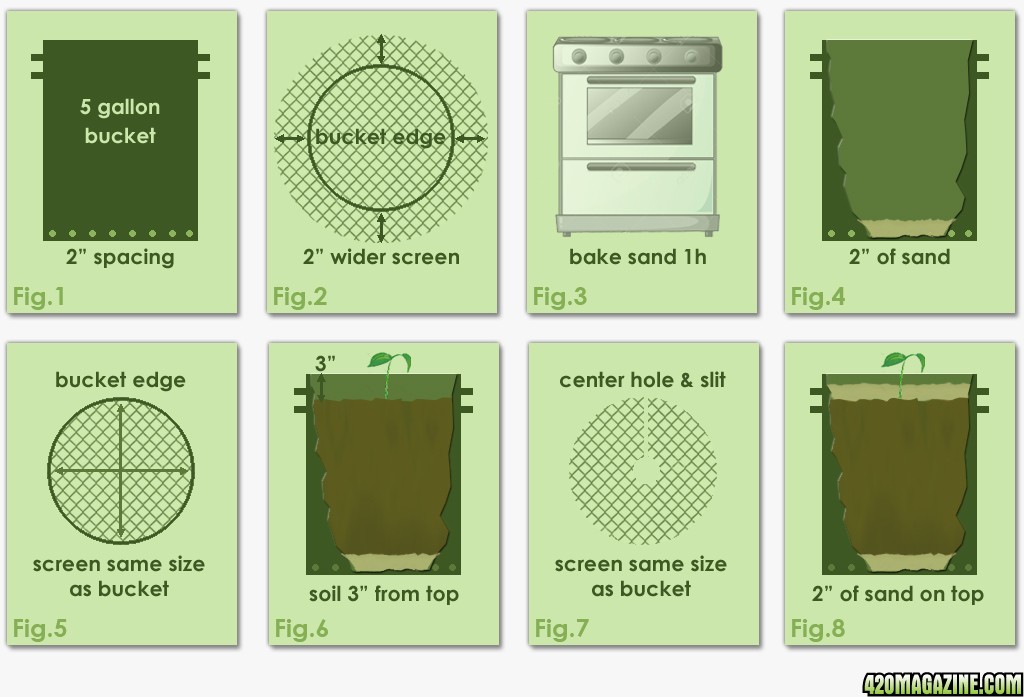quemedica
New Member
Call me old school, but I grow em wide, I grow em tall and I grow em in five gallon buckets filled with soil. Well, not exactly…
Experienced soil growers often take for granted the things which caused them hardships as new growers. You will seldom read about the little things that add up to a pleasant grow. Today I’ll delve into one of these, which is my soil bucket preparation. There are certainly other good methods, but this has worked out well for me for many years now…

Fig.1
Drill ¼” holes spaced 2” apart all around your bucket and as close as possible to the bottom. Yes, that’s a lot of runoff holes, you’ll find out why in a moment.
Fig.2
Cut a round nylon window screen 2” inches wider than the bucket’s diameter and place it evenly across its bottom. This puts the screen’s edge 2” off bottom.
Fig.3
Bake fine grained sand (beach sand) in your oven at 400F (205C) for one hour. This will kill off anything nasty that could of been living in it. I use a metal pail for this and leave it in the oven to cool off overnight.
Fig.4
Add 2” of baked sand across the bucket’s bottom. This is done to prevent fungus gnats from laying their eggs in your runoff holes. No exposed soil, no fungus gnats. If you don’t know what a fungus gnat infestation is like, keep reading and you’ll never find out. Sand is not as porous as soil, which is why we needed to drill more runoff holes than would normally be the case.
Fig.5
Cut another round nylon window screen, but this time the same size as your bucket’s inner diameter and place it over the layer of sand. This will create a barrier discouraging your plant’s roots from digging into the sand.
Fig.6
Fill the bucket with soil leaving 3” at the top. Transplant your cutting or seedling making sure it has at least 2 ½” of stem above soil.
Fig.7
Cut another round nylon window screen the same size as your bucket’s inner diameter. Cut a 2” hole at the center and then a slit from the edge.
Fig.8
Slip the nylon screen over and around your seedling then add 2” of baked sand across the bucket’s diameter.
Don’t worry about your media being too close to the top of the bucket, soil will compress down as time goes by.
Grow long and prosper
Experienced soil growers often take for granted the things which caused them hardships as new growers. You will seldom read about the little things that add up to a pleasant grow. Today I’ll delve into one of these, which is my soil bucket preparation. There are certainly other good methods, but this has worked out well for me for many years now…

Fig.1
Drill ¼” holes spaced 2” apart all around your bucket and as close as possible to the bottom. Yes, that’s a lot of runoff holes, you’ll find out why in a moment.
Fig.2
Cut a round nylon window screen 2” inches wider than the bucket’s diameter and place it evenly across its bottom. This puts the screen’s edge 2” off bottom.
Fig.3
Bake fine grained sand (beach sand) in your oven at 400F (205C) for one hour. This will kill off anything nasty that could of been living in it. I use a metal pail for this and leave it in the oven to cool off overnight.
Fig.4
Add 2” of baked sand across the bucket’s bottom. This is done to prevent fungus gnats from laying their eggs in your runoff holes. No exposed soil, no fungus gnats. If you don’t know what a fungus gnat infestation is like, keep reading and you’ll never find out. Sand is not as porous as soil, which is why we needed to drill more runoff holes than would normally be the case.
Fig.5
Cut another round nylon window screen, but this time the same size as your bucket’s inner diameter and place it over the layer of sand. This will create a barrier discouraging your plant’s roots from digging into the sand.
Fig.6
Fill the bucket with soil leaving 3” at the top. Transplant your cutting or seedling making sure it has at least 2 ½” of stem above soil.
Fig.7
Cut another round nylon window screen the same size as your bucket’s inner diameter. Cut a 2” hole at the center and then a slit from the edge.
Fig.8
Slip the nylon screen over and around your seedling then add 2” of baked sand across the bucket’s diameter.
Don’t worry about your media being too close to the top of the bucket, soil will compress down as time goes by.
Grow long and prosper



